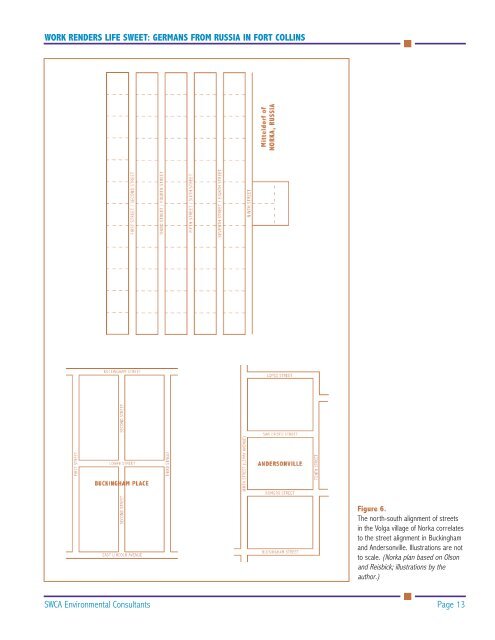germans from russia in fort collins, 1900-2000 - Libraries
germans from russia in fort collins, 1900-2000 - Libraries germans from russia in fort collins, 1900-2000 - Libraries
WORK RENDERS LIFE SWEET: GERMANS FROM RUSSIA IN FORT COLLINS Figure 6. The north-south alignment of streets in the Volga village of Norka correlates to the street alignment in Buckingham and Andersonville. Illustrations are not to scale. (Norka plan based on Olson and Reisbick; illustrations by the author.) SWCA Environmental Consultants Page 13
WORK RENDERS LIFE SWEET: GERMANS FROM RUSSIA IN FORT COLLINS was rigidly oriented north-south and seemed to fit perfectly the general pattern of construction in Russia. Moreover, Alta Vista, or Spanish Colony, Great Western’s hispanic labor settlement northwest of Andersonville, exhibits no such north-south arrangement. 50 Ebers also points out that post-flood Buckingham and Andersonville were unique in that, unlike Alta Vista or mining towns, these neighborhoods were not true company towns. Andersonville was private enterprise, while the houses in Buckingham were a collaboration of the sugar company and beet farm owners. The neighborhoods did have some limited similarities to company towns, particularly that the factory was the focal point around which the towns were established. But there was not a company store or company-endorsed (often enforced) architectural standard. 51 A small, privately-owned grocery store did emerge early in Buckingham’s history. The false-front, woodframe retail structure, located near the corner of First Street and Lincoln Avenue, appears in photographs of the 1904 flood. It has survived numerous floods since then and stands today. 52 German-Russian Domestic Architecture The dwellings of Germans from Russia in the Fort Collins area could vary as widely as an old wooden boxcar at the edge of a beet field to a handsome cottage in Andersonville. In some cases, families might have lived in a field-side shanty during the beet campaign (from March to November) and resided the rest of the year in a more sophisticated house near the sugar factory, where the found employment. The earliest dwellings in Buckingham appear to have been identical beet shacks based on a plan or kit common to northern Colorado, while Andersonville featured more high-style cottages. The 1904 flood seemed to have balanced development in both neighborhoods; modest, late Victorian and, later, simple Craftsman homes replaced the beet shacks and temporary housing. As mentioned before, by late December 1902 Buckingham boasted thirteen houses measuring twenty-by-twelve feet with four small, square windows. The most notable feature, however, was the shallowly arced, rounded roof. The dimensions and descriptions of these shacks resemble those of simi- Figures 7 and 8. Top: A typical northern Colorado beet shanty, circa 1923. Bottom: A contemporary photograph of a beet shanty on Third Street in Buckingham. This view is to the southeast. Note the shedroof addition to the south side and the square windows. This is most likely a survivor of the 1904 flood. (Top photo from U.S. Department of Labor; bottom photo by the author) SWCA Environmental Consultants Page 14
- Page 2 and 3: WORK RENDERS LIFE SWEET: GERMANS FR
- Page 4 and 5: INTRODUCTION Second Hoeing, Second
- Page 6 and 7: SECTION I Germans in Russia and the
- Page 8 and 9: WORK RENDERS LIFE SWEET: GERMANS FR
- Page 10 and 11: WORK RENDERS LIFE SWEET: GERMANS FR
- Page 12 and 13: WORK RENDERS LIFE SWEET: GERMANS FR
- Page 14 and 15: WORK RENDERS LIFE SWEET: GERMANS FR
- Page 16 and 17: WORK RENDERS LIFE SWEET: GERMANS FR
- Page 20 and 21: WORK RENDERS LIFE SWEET: GERMANS FR
- Page 22 and 23: WORK RENDERS LIFE SWEET: GERMANS FR
- Page 24 and 25: WORK RENDERS LIFE SWEET: GERMANS FR
- Page 26 and 27: WORK RENDERS LIFE SWEET: GERMANS FR
- Page 28 and 29: WORK RENDERS LIFE SWEET: GERMANS FR
- Page 30 and 31: WORK RENDERS LIFE SWEET: GERMANS FR
- Page 32 and 33: WORK RENDERS LIFE SWEET: GERMANS FR
- Page 34 and 35: SECTION III Source Study and Data G
- Page 36 and 37: NOTES 1. Hope Williams Sykes, Secon
- Page 38 and 39: WORK RENDERS LIFE SWEET: GERMANS FR
- Page 40 and 41: BIBLIOGRAPHY Primary Sources Oral H
- Page 42 and 43: WORK RENDERS LIFE SWEET: GERMANS FR
WORK RENDERS LIFE SWEET: GERMANS FROM RUSSIA IN FORT COLLINS<br />
Figure 6.<br />
The north-south alignment of streets<br />
<strong>in</strong> the Volga village of Norka correlates<br />
to the street alignment <strong>in</strong> Buck<strong>in</strong>gham<br />
and Andersonville. Illustrations are not<br />
to scale. (Norka plan based on Olson<br />
and Reisbick; illustrations by the<br />
author.)<br />
SWCA Environmental Consultants Page 13



